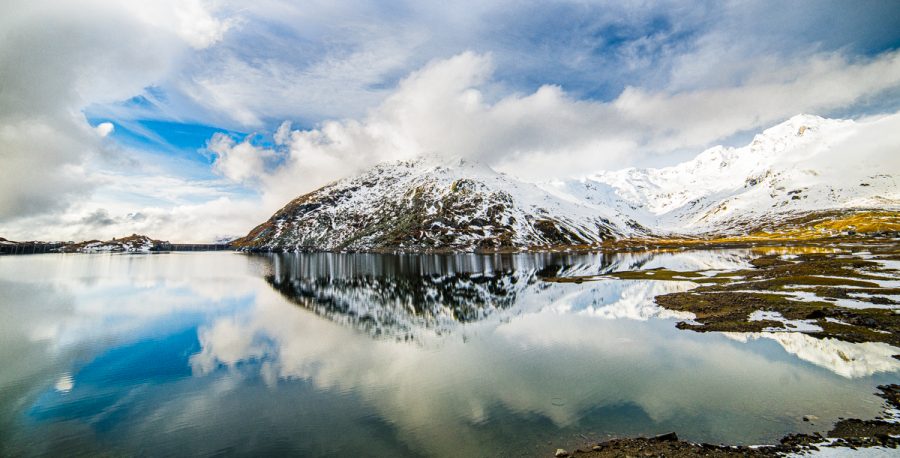Fifty years ago today, more than twenty million people took to the streets in towns and cities across the U.S. in what was and remains the largest environmental protest in history. On that evening’s news, CBS anchor, Walter Cronkite intoned: “a unique day in American history is ending, a day set aside for a nationwide outpouring of mankind seeking its own survival”.
Cronkite went on to describe Earth Day as an effort at “saving lives from the deadly by-products of that bounty – the fouled skies, the filthy waters, the littered Earth”. One in 10 of the then entire population of America took some part in Earth Day, with bipartisan support across the political spectrum, as well as from both urban and rural areas.
While it harnessed the momentum of the protest and social movements of the late 1960s, such as the anti-war, civil rights and women’s movements, the enduring effect of Earth Day was to be at a political and policy level: by the end of 1970, the (Republican) Nixon administration, bowing to the public mood and with the 1972 presidential election in mind, sanctioned the creation of the U.S. Environmental Protection Agency, as well as passing a raft of highly significant environmental laws and regulations.
Notable among these were the National Environmental Education Act, the Occupational Safety and Health Act, and, crucially, the Clean Air Act. In 1972, the U.S. Congress also passed the Clean Water Act, and in 1973, the Endangered Species Act became law. In the years that followed, a raft of other federal laws and regulations were enacted.
Given the vast influence of the U.S., these regulations in turn were widely emulated around the world and have had profound and enduring impacts on water and air pollution in particular in many parts of the so-called developed world, including Ireland.

William_Ruckelshaus being sworn in as the first EPA Administrator under President Richard Nixon.
Hyper-partisan politics
Viewed through the political prism of today’s deeply dysfunctional and hyper-partisan U.S. politics, it seems almost quaint to recall a time when people, irrespective of their politics, religion or skin colour, broadly agreed that eliminating deadly toxins from the air that they breathed and the water that their children drank was a good idea.
Fifty years later, the ideologically toxic Trump regime is busily dismantling large chunks of the progressive regulatory framework that the actions of the U.S. environmental movement ushered into being in 1970. Most sane people think it’s probably a bad idea to allow high levels of mercury, a potent and irreversible neurotoxin, to be released into the air from coal-burning plants.
Yet regulations limiting mercury emissions from coal-burning are currently being scrapped by Trump. So are rules blocking leaking and venting of hydrofluorocarbons from large air conditioning and refrigeration systems. These chemicals are highly potent greenhouse gases and, according to a 2015 NASA study, are also contributing to global ozone depletion.

People’s Climate March, Washington DC, 2017.
Criminal enterprise
A devastating list of 95 of the major recent assaults by the Trump administration on environmental regulations was compiled by the New York Times late last year. Anyone still labouring under the impression that this is anything other than a family-run criminal enterprise, abetted by some of the most corrupt politicians/grifters in the long and often deeply corrupt history of U.S. politics, should take some time to review this list.
But the key point remains: the original Earth Day was the foundation event for the modern environmental movement, and affected enduring changes in public and political attitudes towards pollution in particular, especially where the evidence of its deleterious effects were impossible to conceal.
Air and water quality in the developed world improved markedly from the 1970s onwards, partially arising from Earth Day legacy, but also due to the offshoring of much of the West’s highly polluting heavy industries, which had triggered the crisis.
So, wealthy countries began to de-industrialise, not by consuming less and living more modestly, but by shifting the axis of production – and pollution – over the horizon, to poorer countries where environmental standards were mostly non-existent and where politicians and public officials could far more easily be paid to look the other way, and desperate workers would accept a pittance to work in conditions dangerous to their own health and damaging to the communities where they lived.
Global warming

Ivan Pellacani (wikicommons)
Another crucial element missing entirely from the original Earth Day was any consideration of global warming. While the concept was well understood within the scientific community by then, it had zero traction in the wider public, and much of the scientific establishment treated it more as an academic conundrum about what could possibly happen at some date several decades hence.
In 1970, global carbon dioxide (CO2) levels stood at 325 parts per million (ppm), having risen from 316ppm when systematic scientific measurements began in 1958. The highest pre-industrial CO2 levels had stood at 280ppm, so the atmosphere in 1970 was already carrying 15% more CO2 than before the industrial revolution.
This matters enormously, as the trace gas, CO2 is the atmosphere’s key chemical thermostat. Dial it up, and temperature rise, almost in lock-step. What about in the fifty years since then? Today, global CO2 levels stand at around 416ppm, which means it has risen by over a quarter in just five decades.
This is likely the most rapid shift in atmospheric chemistry in Earth history. The last time there were CO2 levels this high was in the Pliocene, an era from 5.3 to 2.6 million years ago. Then, sea levels were 20 metres higher than today, and trees grew at the South Pole, and overall global temperatures were 3-4ºC higher than today.
This unprecedented spike in atmospheric CO2 levels since 1970 will continue to impact temperatures on this planet for centuries into the future. Already, it has led to a rise in the average global surface temperature by just over 1ºC versus pre-industrial. This is the largest single temperature shift since the end of the last Ice Age.
The Intergovernmental Panel on Climate Change (IPCC) estimates that the red line for dangerous and irreversible changes to the Earth’s climate system lies at around 1.5ºC, which is already perilously close to today’s levels. The IPCC advises that every effort must be made to decarbonise the global economy to avoid such a scenario.
Based on today’s level of emissions, the global ‘carbon budget’ for +1.5ºC will have been exhausted by 2030. Even the economic downturn arising from the coronavirus pandemic (estimated to see a 5% cut in emissions this year) may only slow this process down by a matter of months.
To avoid breaching the +1.5ºC danger line by 2030, global emissions will need to have fallen by a staggering 60% by then. Nothing short of a global political, economic, social and cultural revolution could effect such a profound transition in such a tight timeframe. In reality, our current economic model, coronavirus notwithstanding, sees emissions actually accelerating at the time we need to be hitting the brakes and bracing for impact.
Anthropocene

Under threat: Mountain Gorillas.
However dramatic the rise in global emissions and temperatures have been in the last five decades, this almost pales into insignificance when measured against the toll humanity has taken on the natural world over this period. We have eradicated almost two thirds of all the wild mammals, birds, fish and reptiles in just 50 years.
The last time a global mass die-off on this scale occurred was some 66 million years ago, in the wake of the asteroid impact that led to the extinction of all non-avian dinosaurs. Many scientists have already designated the current era as the Anthropocene, the era of human impacts, and state that the sixth great mass extinction event in Earth history is already well underway.
Researchers used the term ‘biological annihilation’ to describe the nature and extent of what they termed the ‘frightening assault on the foundations of human civilisation’. It should be borne in mind that while this carnage ultimately threatens humanity, it has already laid waste to hundreds of millions of years of evolutionary progress and, in the process, brutally simplified countless once-complex ecosystems.
“The situation has become so bad it would not be ethical not to use strong language”, said Prof Gerardo Ceballos of the National University in Mexico, commenting on the major study published in the peer-reviewed journal Proceedings of the National Academy of Sciences.
Today, over three quarters of the entire world’s land surface has been ‘significantly altered’ by human actions, with tens of millions of hectares of forests razed and cleared for agriculture. The hunting of wildlife for food is another force accelerating extinctions, with at least 300 species of mammals facing near-term extinctions as a direct result of the bushmeat trade.
At sea, the anarchy is even worse. Over 90% of the world’s large predatory fish, from sharks to tuna, marlin and swordfish, are already gone, with many species now on the brink of extinction. Studies project that as soon as 2048, the world’s oceans will essentially have been emptied of fish.
The vast fishing fleets that scour the oceans have the capacity to catch-and-destroy fish far more quickly than species can breed. Further, ocean acidification as a result of global warming is accelerating, while surface water temperatures are rising quickly, further disrupting marine life.
On top of this, tens of millions of tons of plastic waste is ending up in the world’s oceans every year, then slowly degrading from polymers into near-microscopic monomers, trillions of which are now contaminating the base of the entire marine food chain, as these pollutants are being inadvertently ingested by marine creatures from krill to sea birds. One estimate states that there will be more plastic in the world’s oceans by 2050 than fish.
‘We are stealing the future’
It hasn’t all been one-way traffic. As nature has waned, the human footprint has expanded inexorably. Since 1970, the global population has more than doubled, from 3.7 billion to over 7.8 billion today. In 1970, the total gross domestic product (GDP) of the world economy was around $23.8 trillion (in 2011 values) but by 2019, this had quadrupled, to almost $90 trillion.
Californian environmentalist and author Paul Hawken’s description of the predatory nature and mindset associated with the cult of endless economic expansion has never been bettered: “we are stealing the future, selling it in the present, and calling it GDP”.
While the original Earth Day was inspired by people’s experience of ecological degradation they could see and even smell all around them, and while it achieved some notable successes as detailed earlier, its ultimate legacy is one of acute failure.
We humans proved unable (or unwilling) to extend our empathy to other species, to nature itself, and to act unselfishly on behalf of people in other places, or indeed of all future generations. This did not of course happen by accident.
Neo-liberal thought
Generations of neo-liberal thought have helped inure humanity against the pain of the natural world and the suffering of others, both humans and fellow sentient animals, while shielding the billionaire predators, who have profiteered from this ruin, which is the consequences of their actions and inactions.
Our species achieved spectacular evolutionary success not just by brute force and violence, but primarily by our ability to cooperate, and the strength and complexity of our social structures. These have been worn threadbare by decades of atomised consumerism.
This too did not happen by accident. Fifteen years before the inaugural Earth Day, US economist, Victor Lebow laid out the template for the brave new world of expansion and consumption in 1955: “our enormously productive economy demands that we make consumption our way of life, that we convert the buying and use of goods into rituals, that we seek our spiritual satisfaction and our ego satisfaction in consumption. We need things consumed, burned up, worn out, replaced and discarded at an ever-increasing rate.”
The Consumer Age is now at an end; replaced, I would posit, by the Age of Consequences. As the industrial revolution began in earnest in the early 19th century, poet William Wordsworth, perhaps sensing the fatal shift then underway in humanity’s relationship with nature, wrote presciently:
The world is too much with us; late and soon,
Getting and spending, we lay waste our powers;—
Little we see in Nature that is ours;
We have given our hearts away, a sordid boon!
This Sea that bares her bosom to the moon;
The winds that will be howling at all hours,
And are up-gathered now like sleeping flowers;
For this, for everything, we are out of tune
Featuring image by Daniele Idini / Cassandra Voices




